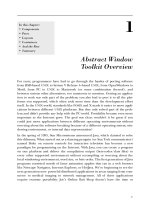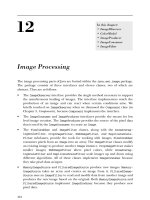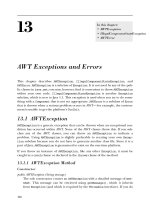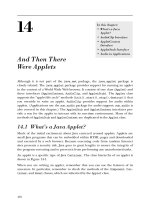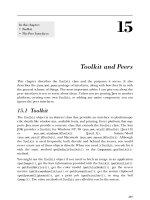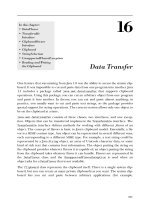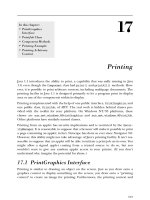Introduction to java lecture
Bạn đang xem bản rút gọn của tài liệu. Xem và tải ngay bản đầy đủ của tài liệu tại đây (67.76 KB, 22 trang )
Introduction to Java
CS 331
Introduction
•
Present the syntax of Java
•
Introduce the Java API
•
Demonstrate how to build
–
stand-alone Java programs
–
Java applets, which run within
browsers e.g. Netscape
•
Example programs
Why Java?
•
It’s the current “hot” language
•
It’s almost entirely object-oriented
•
It has a vast library of predefined objects and operations
•
It’s more platform independent
–
this makes it great for Web
programming
•
It’s more secure
•
It isn’t C++
Applets, Servlets and
Applications
•
An applet is designed to be embedded in a Web page, and
run by a browser
•
Applets run in a sandbox with numerous restrictions; for
example, they can’t read files and then use the network
•
A servlet is designed to be run by a web server
•
An application is a conventional program
Building Standalone JAVA
Programs (on UNIX)
•
Prepare the file foo.java using an editor
•
Invoke the compiler: javac foo.java
•
This creates foo.class
•
Run the java interpreter: java foo
Java Virtual Machine
•
The .class files generated by the compiler are not executable
binaries
–
so Java combines compilation and
interpretation
•
Instead, they contain “byte-codes” to be executed by the Java
Virtual Machine
–
other languages have done this,
e.g. UCSD Pascal
•
This approach provides platform independence, and greater
security
HelloWorld (standalone)
public class HelloWorld {
public static void main(String[] args) {
System.out.println("Hello World!");
}
}
•
Note that String is built in
•
println is a member function for the System.out class
Comments are almost like C++
•
/* This kind of comment can span multiple lines
*/
•
// This kind is to the end of the line
•
/**
* This kind of comment is a special
* ‘javadoc’ style comment
*/
Primitive data types are like C
•
Main data types are int, double,
boolean, char
•
Also have byte, short, long, float
•
boolean has values true and false
•
Declarations look like C, for example,
–
double x, y;
–
int count = 0;
Expressions are like C
•
Assignment statements mostly look like those in C; you
can use =, +=, *= etc.
•
Arithmetic uses the familiar + - * / %
•
Java also has ++ and
•
Java has boolean operators && || !
•
Java has comparisons < <= == != >= >
•
Java does not have pointers or pointer arithmetic
Control statements are like C
•
if (x < y) smaller = x;
•
if (x < y){ smaller=x;sum += x;}
else { smaller = y; sum += y; }
•
while (x < y) { y = y - x; }
•
do { y = y - x; } while (x < y)
•
for (int i = 0; i < max; i++)
sum += i;
•
BUT: conditions must be boolean !
Control statements II
•
Java also introduces the try statement, about which more
later
switch (n + 1) {
case 0: m = n - 1; break;
case 1: m = n + 1;
case 3: m = m * n; break;
default: m = -n; break;
}
Java isn't C!
•
In C, almost everything is in functions
•
In Java, almost everything is in classes
•
There is often only one class per file
•
There must be only one public class per file
•
The file name must be the same as the name of that public
class, but with a .java extension
Java program layout
•
A typical Java file looks like:
import java.awt.*;
import java.util.*;
public class SomethingOrOther {
// object definitions go here
. . .
}
This must be in a file named SomethingOrOther.java !
What is a class?
•
Early languages had only arrays
–
all elements had to be of the same
type
•
Then languages introduced structures (called
records, or structs)
–
allowed different data types to be
grouped
•
Then Abstract Data Types (ADTs) became popular
–
grouped operations along with the data
So, what is a class?
•
A class consists of
–
a collection of fields, or
variables, very much like the named
fields of a struct
–
all the operations (called methods)
that can be performed on those
fields
–
can be instantiated
•
A class describes objects and operations defined on those objects
Name conventions
•
Java is case-sensitive; maxval, maxVal, and MaxVal are
three different names
•
Class names begin with a capital letter
•
All other names begin with a lowercase letter
•
Subsequent words are capitalized: theBigOne
•
Underscores are not used in names
•
These are very strong conventions!
The class hierarchy
•
Classes are arranged in a hierarchy
•
The root, or topmost, class is Object
•
Every class but Object has at least one superclass
•
A class may have subclasses
•
Each class inherits all the fields and methods of its (possibly
numerous) superclasses
An example of a class
class Person {
String name;
int age;
void birthday ( ) {
age++;
System.out.println (name + ' is
now ' + age);
}
}
Another example of a class
class Driver extends Person {
long driversLicenseNumber;
Date expirationDate;
}
Creating and using an object
•
Person john;
john = new Person ( );
john.name = "John Smith";
john.age = 37;
•
Person mary = new Person ( );
mary.name = "Mary Brown";
mary.age = 33;
mary.birthday ( );
An array is an object
•
Person mary = new Person ( );
•
int myArray[ ] = new int[5];
–
or:
•
int myArray[ ] = {1, 4, 9, 16, 25};
•
String languages [ ] = {"Prolog",
"Java"};
